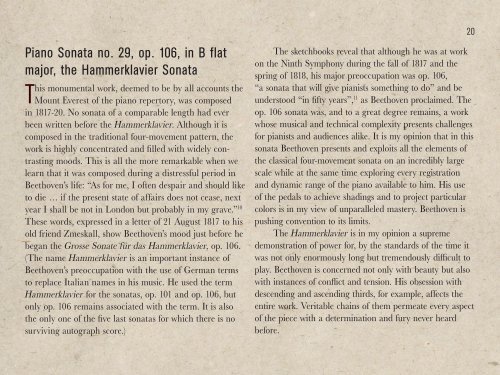LATE BEETHOVEN LATE BEETHOVEN - Luisa Guembes-Buchanan
LATE BEETHOVEN LATE BEETHOVEN - Luisa Guembes-Buchanan
LATE BEETHOVEN LATE BEETHOVEN - Luisa Guembes-Buchanan
Sie wollen auch ein ePaper? Erhöhen Sie die Reichweite Ihrer Titel.
YUMPU macht aus Druck-PDFs automatisch weboptimierte ePaper, die Google liebt.
Piano Sonata no. 29, op. 106, in B flat<br />
major, the Hammerklavier Sonata<br />
This monumental work, deemed to be by all accounts the<br />
Mount Everest of the piano repertory, was composed<br />
in 1817-20. No sonata of a comparable length had ever<br />
been written before the Hammerklavier. Although it is<br />
composed in the traditional four-movement pattern, the<br />
work is highly concentrated and filled with widely contrasting<br />
moods. This is all the more remarkable when we<br />
learn that it was composed during a distressful period in<br />
Beethoven’s life: “As for me, I often despair and should like<br />
to die … if the present state of affairs does not cease, next<br />
year I shall be not in London but probably in my grave.” 10<br />
These words, expressed in a letter of 21 August 1817 to his<br />
old friend Zmeskall, show Beethoven’s mood just before he<br />
began the Grosse Sonate für das Hammerklavier, op. 106.<br />
(The name Hammerklavier is an important instance of<br />
Beethoven’s preoccupation with the use of German terms<br />
to replace Italian names in his music. He used the term<br />
Hammerklavier for the sonatas, op. 101 and op. 106, but<br />
only op. 106 remains associated with the term. It is also<br />
the only one of the five last sonatas for which there is no<br />
surviving autograph score.)<br />
20<br />
The sketchbooks reveal that although he was at work<br />
on the Ninth Symphony during the fall of 1817 and the<br />
spring of 1818, his major preoccupation was op. 106,<br />
“a sonata that will give pianists something to do” and be<br />
understood “in fifty years”, 11 as Beethoven proclaimed. The<br />
op. 106 sonata was, and to a great degree remains, a work<br />
whose musical and technical complexity presents challenges<br />
for pianists and audiences alike. It is my opinion that in this<br />
sonata Beethoven presents and exploits all the elements of<br />
the classical four-movement sonata on an incredibly large<br />
scale while at the same time exploring every registration<br />
and dynamic range of the piano available to him. His use<br />
of the pedals to achieve shadings and to project particular<br />
colors is in my view of unparalleled mastery. Beethoven is<br />
pushing convention to its limits.<br />
The Hammerklavier is in my opinion a supreme<br />
demonstration of power for, by the standards of the time it<br />
was not only enormously long but tremendously difficult to<br />
play. Beethoven is concerned not only with beauty but also<br />
with instances of conflict and tension. His obsession with<br />
descending and ascending thirds, for example, affects the<br />
entire work. Veritable chains of them permeate every aspect<br />
of the piece with a determination and fury never heard<br />
before.


